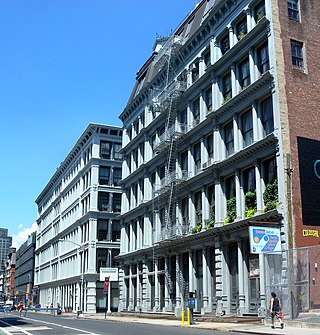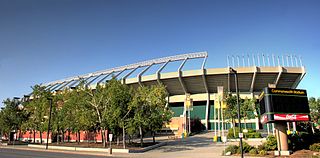
SoHo, short for "South of Houston Street", is a neighborhood in Lower Manhattan, New York City. Since the 1970s, the neighborhood has been the location of many artists' lofts and art galleries, and has also been known for its variety of shops ranging from trendy upscale boutiques to national and international chain store locations. The area's history is an archetypal example of inner-city regeneration and gentrification, encompassing socioeconomic, cultural, political, and architectural developments.

Sherwood Park is a large hamlet in Alberta, Canada within Strathcona County that is recognized as an urban service area. It is located on traditional Treaty 6 territory, and adjacent to the City of Edmonton's eastern boundary. While long confined to generally south of Highway 16, west of Highway 21 and north of Highway 630, portions of Sherwood Park have expanded beyond Yellowhead Trail and Wye Road since the start of the 21st century. Anthony Henday Drive (Highway 216) separates Refinery Row, in a portion of the Sherwood Park Urban Service Area to the west, from the residential and commercial hamlet to the east.

Strathcona County is a specialized municipality in the Edmonton Metropolitan Region within Alberta, Canada between Edmonton and Elk Island National Park. It forms part of Census Division No. 11.

Harrison West is a historic urban neighborhood located northwest of downtown Columbus, Ohio. It sits on several blocks along the Olentangy River and includes the western part of the Near Northside Historic District, which was placed on the National Register of Historic Places in 1975. The character of the neighborhood is similar to Victorian Village, which sits just to the east and is more well-known.

McCauley is an ethnically diverse inner city neighbourhood in Edmonton, Alberta, undergoing revitalization. It is named for Matthew McCauley, the first mayor of Edmonton, and is located just to the north east of the Downtown core. McCauley is known as the home of religious buildings in a small area, as well as being a large venue for the 1978 Commonwealth Games.

Woodcroft is a neighbourhood located in northwest Edmonton, Alberta, Canada. Surrounded by a mixture of residential neighbourhoods and light industrial subdivisions, it is bounded by 118 Avenue to the north, Groat Road to the east, 111 Avenue to the south, and 142 Street to the west. The neighbourhoods is home to Coronation Park and the Telus World of Science.
Mayfield is a neighbourhood in west Edmonton, Alberta, Canada named for famed Canadian aviator and bush pilot Wop May.
Crestwood is a residential neighbourhood in west Edmonton, Alberta, Canada, overlooking the North Saskatchewan River valley and nestled between two ravines.
High Park is a neighbourhood in west Edmonton, Alberta, Canada. The neighbourhood became a part of Edmonton when the Town of Jasper Place amalgamated with Edmonton in 1964.
Westview Village, or Westview Village Manufactured Home Community, is a neighbourhood located in west Edmonton, Alberta, Canada. A manufactured home community, it is located on the west side of Winterburn Road at 107 Avenue NW. The area was part of Parkland County until the 1982 Edmonton general annexation.
Duggan is a residential neighbourhood in south Edmonton, Alberta, Canada. The neighbourhood is "named for John Joseph Duggan (1868-1952), an early businessman and mayor of the town of Strathcona and the City of Strathcona. He is remembered by the Duggan House on Saskatchewan Drive, the Duggan School and the Duggan Bridge.

McQueen is a residential neighbourhood located in west Edmonton, Alberta, Canada. It is named for the Rev. David George McQueen, who served 43 years as minister at Edmonton's First Presbyterian Church from 1887 to 1930.
Newton is a residential neighbourhood located in north east Edmonton, Alberta, Canada.
North Glenora is a residential neighbourhood in west Edmonton, Alberta, Canada. The neighbourhood is bounded on the north by 111 Avenue, on the south by 107 Avenue, on the east by Groat Road, and on the west by 142 Street. Groat Road provides access to locations on the south side, including the University of Alberta and Whyte Avenue.
Dovercourt is a residential neighbourhood in north west Edmonton, Alberta, Canada. While the area was originally annexed by the City of Edmonton in 1913, residential development did not occur until after the end of World War II.
The City of Edmonton has experienced a series of municipal boundary adjustments over its history since originally incorporating as a town in 1892 through incorporation as a city, amalgamation or annexation of other urban municipalities, annexation of rural lands from its surrounding neighbours, and separation of lands back to its rural neighbours. Its most recent annexations, which came into effect on January 1, 2019, involved acquisition of lands from predominantly Leduc County as well as Beaumont and Sturgeon County.

The Ford Parts and Accessories Depot of Edmonton, Alberta, Canada is a historic building in the neighborhood of Huff Bremner Estate. In 2006, the building was added to the Edmonton Inventory of Historic Sites on the basis of its "Early Modern architecture in the International Style".
Kelvin Crawford Stanley was a Canadian architect based in Edmonton, Alberta from 1946 until 1964. He subsequently worked in Montreal and Ottawa in the late 1960s.

The Paramount Theatre is a historic movie theatre in Edmonton, Alberta, Canada.










